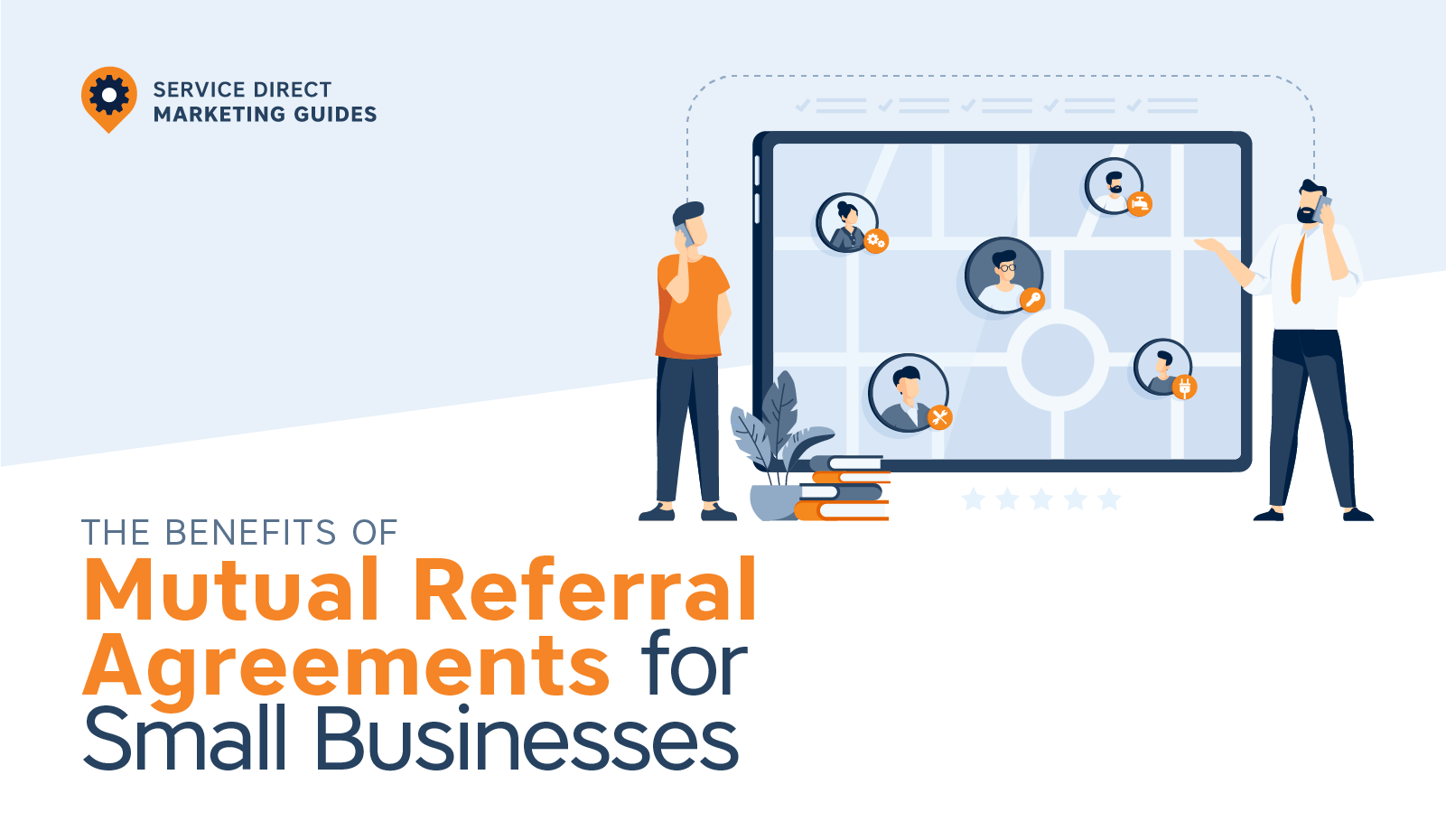The Benefits of Mutual Referral Agreements for Small Businesses
For small businesses, expanding their customer base, reaching new audiences, and establishing a strong foothold is key. But how do you do that?
Successful marketing can be costly and time-consuming. This leaves many small businesses struggling to find cost-effective ways to grow.
In this landscape, referral agreements are a powerful strategy that can boost growth for many small businesses.
By collaborating with non-competing businesses that share a similar target audience, you can unlock many opportunities. These include driving sustainable growth, enhancing brand exposure, and unlocking a fresh pool of potential clients.
When you embrace referral partnership agreements, your small business can navigate the marketplace with greater efficiency. This collaborative approach empowers you to overcome the limitations of expensive marketing while maximizing your resources.
Ultimately, mutual referral agreements will help position your business for sustainable success.
What is a referral agreement?
Referral agreements are contracts between 2 businesses that establish a mutually beneficial partnership for generating new customers.
This partnership allows small businesses to tap into their partner's existing customer network. You will ultimately gain access to a wider audience and expand your brand's reach.
Business referral networks are different from customer referrals. Customer referrals are between an existing customer of yours and a potential new customer. On the other hand, business referrals are between businesses that have decided to work together to mutually grow.
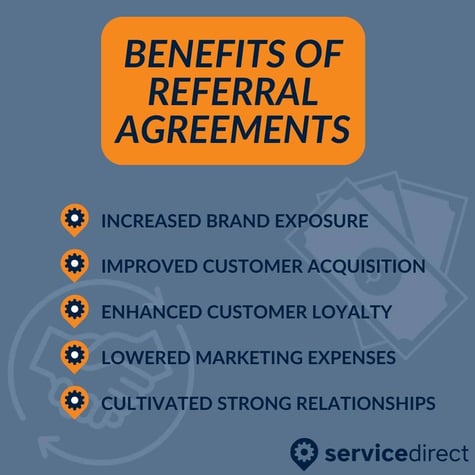
For small businesses, referral agreements provide many cost-effective and efficient benefits, including:
- Increase brand exposure: Reach a wider audience and enhance brand recognition.
- Improve customer acquisition: Attract new customers when other trusted businesses recommend your business.
- Enhance customer loyalty: Build a more engaged and satisfied customer base.
- Lower marketing expenses: Leverage partner networks and marketing efforts.
- Cultivate strong relationships: Collaborate, share knowledge, and explore future opportunities.
Referral agreements help you harness the power of collaboration. This way you can expand your customer reach and pave the way for sustainable growth.
How to build referral partnerships
The success of referral agreements hinges on your ability to identify and establish strong partnerships with complementary businesses.
To do this, you'll want to be sure your audiences align. Additionally, consider which businesses complement your product and the potential for mutually beneficial results.
Identifying Potential Partners
Start by identifying potential partners whose target audience aligns with your own. Consider businesses that cater to a similar customer base and have comparable customer needs.
For example, if you are a mold removal business that doesn't offer mold testing services, you might partner with a local mold testing business that doesn’t offer mold removal services.
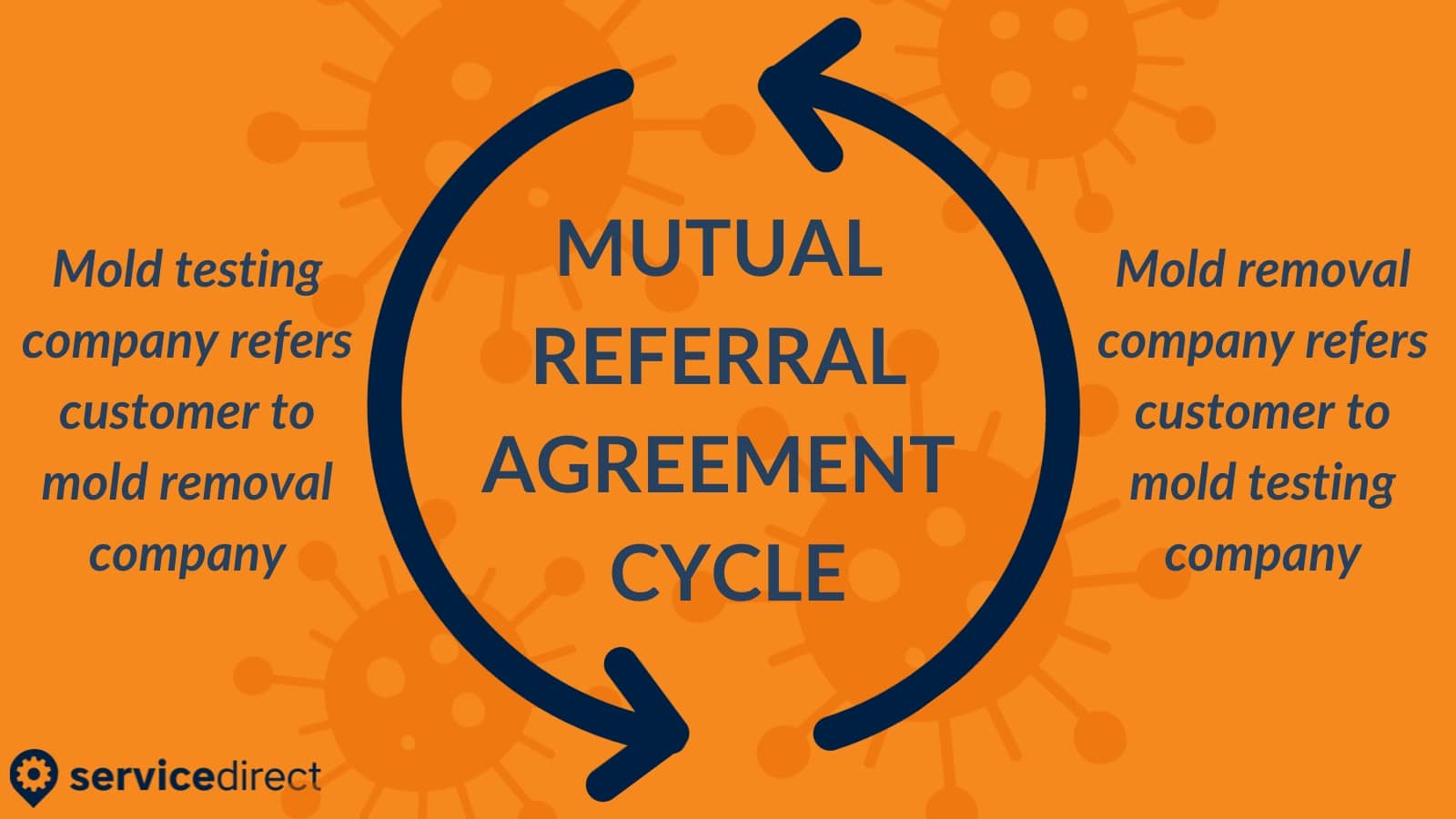
This alignment ensures that you’re reaching the right audience, increasing the likelihood of conversions and new customer acquisition.
Nurturing Relationships With Partners
Once you find some potential partners, the next step is to maintain that relationship and build trust.
Attending industry events and participating in online forums to connect with potential partners is a great place to start. The key is to demonstrate your expertise to establish a rapport and build a foundation for collaboration.
Establishing Clear Terms
It’s crucial to establish clear terms and expectations from the outset. This includes defining the referral fee structure, outlining tracking, and establishing communication protocols.
Clear terms make sure that both businesses are aligned on the goals of the partnership. This helps minimize potential mistakes and maximizes the effectiveness of the referral program.
By following these steps, you should be able to identify, establish, and nurture successful referral partnerships. These partnerships will ultimately help expand your customer base without breaking the bank.
Essential Elements of a Successful Referral Agreement
To harness the full potential of a mutual referral network, it’s crucial to create a well-structured agreement. To do this, you need to clearly outline the terms and expectations of the partnership.
However, you’ll also want to ensure you maintain a level of flexibility with the partnership. You’re not the only business involved, after all.
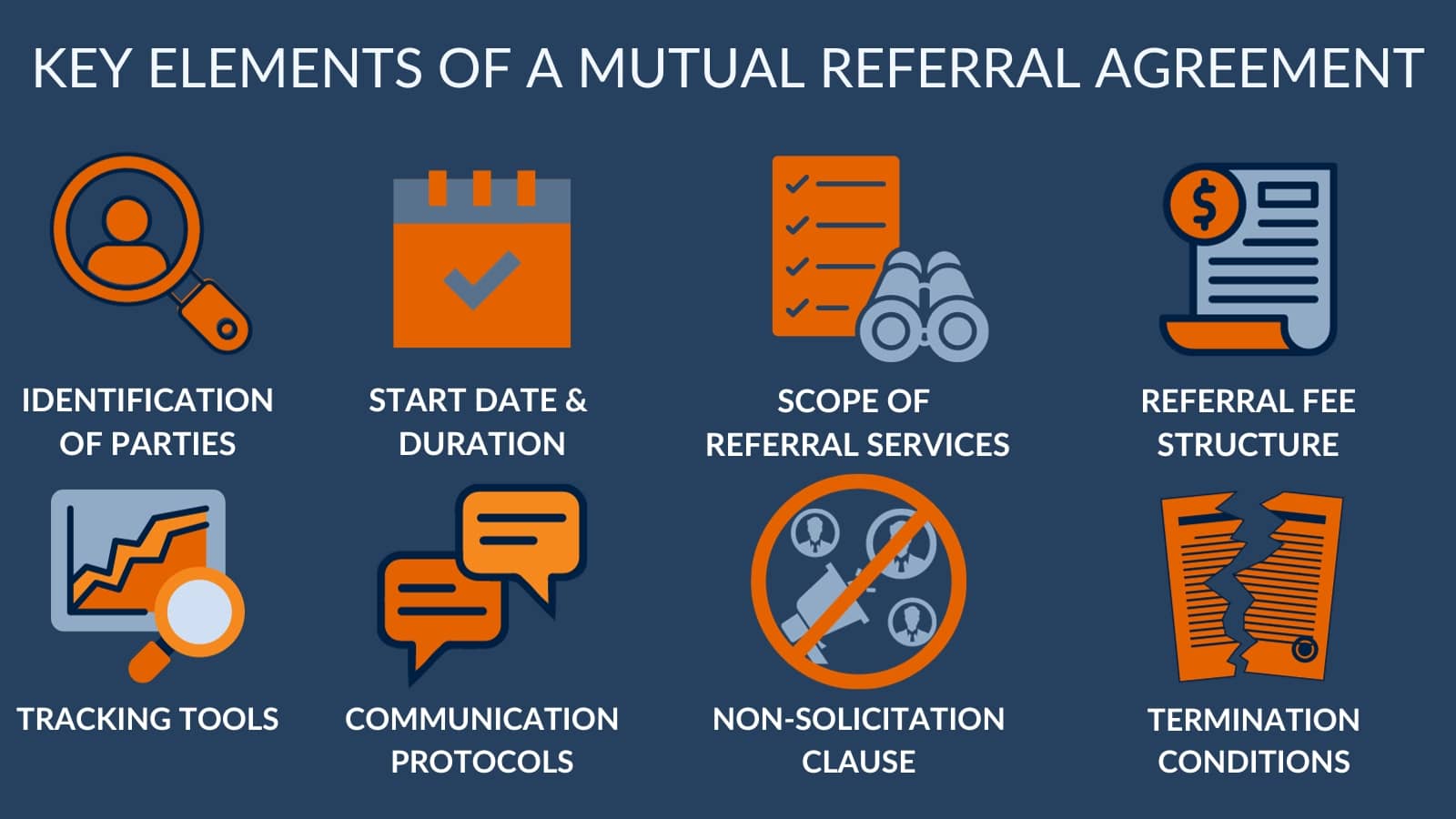
Keep these elements in mind to create a successful and flexible referral partnership:
-
Identification of Parties: Clearly define the parties involved in the agreement, including respective business names, addresses, and contact information.
-
Start Date and Duration: Specify the date on which the agreement becomes effective and the duration of the partnership.
-
Scope of Referral Services: Outline the specific products or services that will be included in the referral partnership.
-
Referral Fee Structure: Clearly define the compensation structure for referrals, including the referral fee percentage, payment terms, and any applicable minimum referral thresholds.
-
Tracking Tools: Establish a system for tracking referrals and attributing conversions to the respective partners.
-
Communication Protocols: Define the communication protocols for exchanging referral information, addressing issues, and maintaining ongoing collaboration.
-
Non-Solicitation Clause: Prevent either party from soliciting the other's employees or customers during the term of the agreement.
-
Termination Conditions: Specify the conditions under which either party may terminate the agreement.
You should keep communication open with the business you are partnering with. This will help build trust and solve minor issues before they threaten the partnership.
By including these key elements in the referral agreement, you can establish a solid foundation for successful referral partnerships.
Don't Forget to Check With Your Local Government
As with any new business changes or partnerships, you must check the legality of the situation. In other words, to avoid legal trouble, double-check with your legal team and local government to ensure your referral agreement is completely in line with regulations.
Although this step may seem excessive, the small amount of time it will take to ensure you're on the right side of the law is nothing compared to the time and money you could lose by unintentionally entering into an agreement that isn't legal.
Tracking and Analyzing Referral Agreement Success
The success of referral agreements extends beyond the initial partnership formation.
To truly maximize the potential of these strategic alliances, businesses must monitor, analyze, and refine their referral programs. This ongoing process ensures that partnerships remain effective and adapt to changing market conditions.
Effective tracking is essential for measuring the performance of referral agreements. Tracking mechanisms should capture key data points. These include the number of referrals generated, the conversion rate of referrals, and the revenue generated from referrals.
By tracking this data, you can assess the effectiveness of your referral program and identify areas for improvement.
Based on what you learn from analyzing data, you can regularly refine your strategy to optimize performance.
This could involve adjusting referral fees, refining the target audience, or testing new methods of sending referrals. Doing this will ensure that your referral programs remain aligned with your evolving business goals.
How to Refer Potential Customers
Now you know what a referral network is and how it can help your business grow. Next, we’ll take some time to look at the process of communicating with customers in referral networks.
We'll continue to build on the earlier example of a mold removal company partnering with a mold testing company as part of a mutual referral agreement.
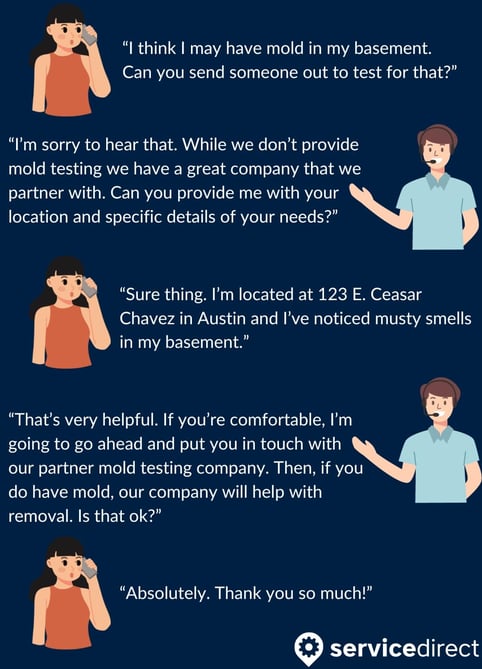
Let’s say a customer reaches out to you, the mold removal company, asking for services. But, they first need someone to come to their property and test for mold. Since you don't provide mold testing services, this is the perfect time for a business referral.
First, you’ll need to determine if the customer is a good fit for your mold testing partner. You don't want to refer a customer who is out of their service area or needs specialized services that your partner doesn’t offer.
Making sure that your partner's offerings address the specific pain points or aspirations of the potential customer is key.
Next, you’ll want to ask the customer for permission to share their contact information and discuss their needs. Remember, you’re hoping to work with this customer down the road so establishing trust from the outset is key.
Respect their privacy and ensure they are comfortable with the referral process before moving forward.
Finally, offer a warm introduction by connecting the customer directly to your mold testing partner. Provide a brief overview of the customer's needs and expectations. Highlight any relevant information that may help in the initial conversation.
Be sure to maintain communication with both the customer and your partner to ensure a smooth referral process. Follow up to determine if the referral resulted in a successful connection or a potential business relationship.
By following these guidelines, you can see the benefits of referral agreements and unlock a world of growth opportunities.
In Conclusion
Referral agreements provide a versatile and effective strategy for your small businesses to expand your customer base. They also help with cost-effective marketing and driving sustainable growth.
By forming partnerships with complementary businesses, you can tap into a wider audience of potential customers, leveraging your partner's established customer networks and reputation.

